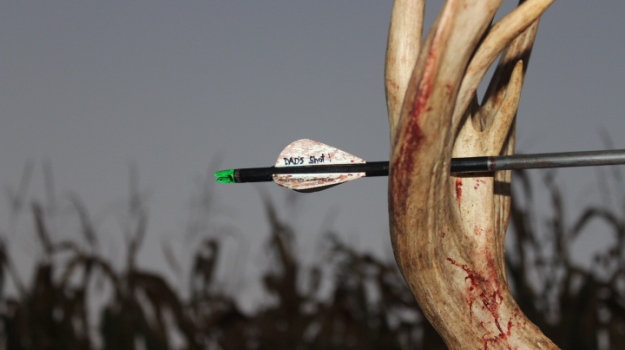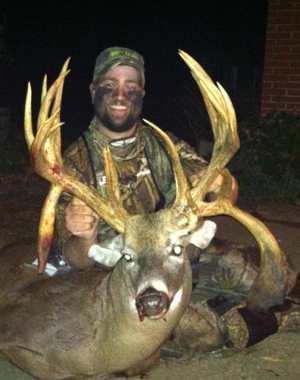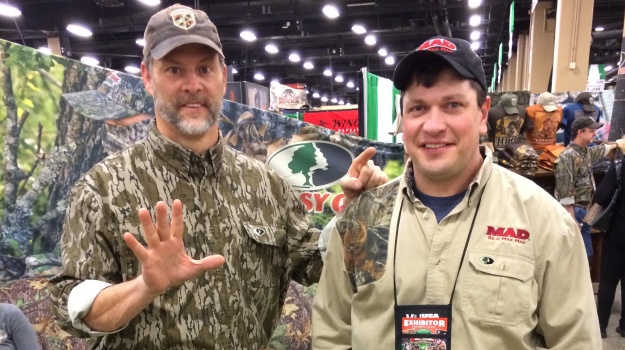
Editor’s Note: Twenty-seven-year-old Mark “Buck” Owen of Wooster, Ohio, found and took a buck of a lifetime wearing Mossy Oak Break-Up Infinity camouflage. He says, “I really like Mossy Oak, because I am also a turkey hunter and like a more-open pattern. I wear the camo I use for deer hunting to hunt turkeys. I’ve been wearing Mossy Oak for 6 years. I was in a sporting-goods store and saw a really-nice coat. I didn’t even look at the camo pattern. I just liked the way the camo looked. I knew it would fit into the terrain I was hunting. So, I bought the coat. When I learned it was Mossy Oak, I started buying my pants, shirts and the rest of my hunting clothes in Mossy Oak. I stuck with the pattern and company, because my success has been in Mossy Oak. I believe that when something’s working for you, you don’t need to leave it. I’ve been a fan of Mossy Oak for a long time, and I see no reason to change.” Owen used his PSE Dream Season DNA bow to take the big buck. The story of how he found the deer, how he got permission to take the deer, and the agony of his defeat before the thrill of his victory makes this story unusual, exciting and a dream come true. This week Owen gives us the secrets of finding big bucks and getting permission to hunt them, as well as the techniques he used to pinpoint when and where that buck would appear, and the way he took this 2nd biggest Ohio bow buck ever.
I got into my tree stand at 4:00 am on opening day of Ohio’s bow deer season, realizing I would be sitting in the dark for at least an hour. As I sat in my Ameristep tree stand and waited for daylight, I kept thinking, “Did I spook any deer as I walked to my tree stand? I don’t think I spooked any, but I’m not sure.” When daylight finally arrived, I watched chipmunks and squirrels for the next 2 hours, while using my Bushnell range finder to check and recheck the distance I was from landmarks all around my stand. I know this sounds stupid, but I just wanted to make sure and have the confidence of knowing that wherever that big deer came in sight, I would know the range before I drew my bow. Occasionally, I used my Bushnell binoculars to look up the trail and scan other trails, in case, the buck possibly might have switched the trail he used, since the last trail camera picture I had of him. About 6:45 am, off to my left, I could hear a deer walking near the area where I thought the big buck was bedding.
I stayed in the stand all day. Before I left the house, I had checked when dusk would occur. It was going to be too dark to shoot by 7:11 pm. At about 6:55 pm, I took my Dream Season DNA off my bow hanger and put it in my lap. When I deer hunt, I always want to have my bow in my lap for the last 30 minutes of daylight, because I have seen more deer at that time than any other time. After I put my bow in my lap, I checked it again to make sure my sight was in place, my arrow nock was tight against the string, and the bow was ready to go, if I needed it. I also checked the time on my cell phone. When I looked up, I saw that big buck coming down the trail about 60-70 yards away from me and spotted that big drop tine. Then, I told myself. “Don’t look at the deer’s head. Look at the place you want to hit.”
He was walking straight to me, coming down the trail from my west to my east. There was a big tree he had to walk behind, before he got into bow range. I had preplanned that when the buck stepped behind the tree, I would make my draw. Each time I looked at the buck, I would look at the trail in front of him. I was searching for other trees he would have to walk past. Then if I couldn’t draw when he got behind the big beech tree, there were three really good sized trees the buck had to pass by that would block his vision to my stand. I made another quick check of my bow to make sure the blades on my broadhead were tucked to the back of the arrow, that the arrow was sitting on the rest and that my mechanical release was clipped on the D-loop. I did a thorough but quick visual inspection of the bow. I knew I was ready to take the shot, but I also needed to know the bow was ready to make the shot.
The buck came in like I thought he would. When he turned to go around the big beech tree, I came to full draw from the sitting position. Now, all the buck had to do was step out from behind that big tree, and the moment I had been dreaming about would happen. The first time I saw the buck on the trail camera pictures. I began to practice shooting from the seated position. I realized if I had a chance to take this buck, I didn’t want to have to stand-up to shoot and give the buck a greater opportunity to see me.
The tree he was behind was one of the main trees I had ranged when I got bored in my tree stand. I knew for certain that tree was at 33 yards. The buck only had to travel about 8 yards from behind the tree to reach a pile of corn that we had put out. Then the buck could see it, and he wouldn’t have to look for individual kernels of corn being thrown out by the feeder. The buck stood behind the tree, stuck his head out, looked at the corn and then looked in all directions with his body still behind the tree. When the buck stepped out, he used his nose to smell all around the corn pile. His right front leg was up close to his nose, giving me a perfect broadside shot to his vitals. Just as I started to release the arrow, the buck jerked his head up, and I froze. As he put his nose back down to feed on the corn, he shifted his weight and moved back just a little bit. In that millisecond, just as he was moving, I had released the arrow. My broadhead hit just in front of his shoulder blade. But because the deer turned a little quartering to me, the broadhead cut the vein that fed the jugular vein.
The arrow was moving so fast. I got a clean pass-though. But when the buck took the arrow, he charged forward straight toward the tree where I was, before veering a little to the right, as he passed about 8 yards from the base of my tree. He only went 12-yards from my tree before he hit the ground face first. My eyes and ears were glued to him. He started making a gurgling sound. Then, all movement stopped. When I saw he wasn’t moving, I told myself, “Don’t get up. Stay seated, stay quiet, and keep your eyes on the buck.” As I sat and watched the deer, I was shaking like a leaf. I waited as long as I possibly could stand to wait – about 5-10 minutes. Finally, I took my Bushnell binoculars, looked at the deer and saw he looked dead. I let my bow and my pack down to the ground. As I sat silently in my stand, I told myself. “Don’t fall. Take your time getting out of the stand, and think through every move you make.” Just before I stepped on the climbing sticks, I detached my safety harness from the tree. I began to slowly and deliberately climb down my climbing sticks. I couldn’t believe how big the deer was, until I put my hands on his antlers. Most of the time, when he was walking toward me, I wasn’t looking at his antlers.
I looked at where the broadhead had entered. The hole was right where his neck and shoulder met. The arrow came out a little behind the offside shoulder. In the pictures, the shot looks like I shot him in the neck. But remember, I was shooting down on him, and the arrow made a complete pass-through. He had two drop tines and a beam that came off one of the drop tines. I couldn’t believe his antlers weren’t outside of his ears. As I looked more closely at his ears, they looked like the ears on a child’s teddy bear, since they were short and rounded. From the trail camera pictures, we thought the buck had between 20-25 points. When I counted the points, he had 22. When the buck was scored, he gross scored 256 on the Buckmaster scale, which doesn’t give any credit for inside main beam width. He won’t be scored for Boone and Crockett, because he had three pedicles (instead of having two places where antlers come out of the skull, this buck had three). Boone and Crockett will only recognize deer with two pedicles. On the Pope and Young scale, the buck should score between 248 and 260. At this writing, the antlers have not been officially scored by P&Y.
 I immediately called the landowner and said, “I got him. He’s down.” The landowner said, “Ok, I am eating dinner. I will be right there, when I finish eating.” Next, I called my wife, Nicky. I told her, “I got the big buck.” After what seemed like an eternity the landowner showed up with his ATV. Before we loaded the deer, I got my arrow and looked at the writing on the white fletching of the arrow that said, “Dad’s Shot.” Adrenaline, excitement, and a feeling I can’t describe went through me. I knew how proud my dad would be, if he could see this buck I just had taken. I believe that from somewhere, he saw me and the buck (see Day 2).
I immediately called the landowner and said, “I got him. He’s down.” The landowner said, “Ok, I am eating dinner. I will be right there, when I finish eating.” Next, I called my wife, Nicky. I told her, “I got the big buck.” After what seemed like an eternity the landowner showed up with his ATV. Before we loaded the deer, I got my arrow and looked at the writing on the white fletching of the arrow that said, “Dad’s Shot.” Adrenaline, excitement, and a feeling I can’t describe went through me. I knew how proud my dad would be, if he could see this buck I just had taken. I believe that from somewhere, he saw me and the buck (see Day 2).
I learned later that as the landowner and I were dragging the buck to the ATV, the trail camera took a picture of us. When we reached the end of the road with the buck in the back of the ATV, my wife was there waiting and was as excited as I was. We got the buck back to the landowner’s house and field dressed him. I called a buddy of mine, who has a walk-in cooler. I asked him if I could leave the buck in the cooler overnight, because I wanted to shoot a lot of pictures of him the next morning. I called some of my other buddies and told them to meet me at the walk-in cooler, and that is when the celebration really took place.
Everyone wanted to know where I had taken the buck. I didn’t tell anyone, since I had made that pledge to the landowner. We shot some pictures that night. The next morning was a fairly lengthy photo session. Jason Danbury, who is the investigator for wildlife crime for the State of Ohio, is a friend of my buddy who owned the walk-in cooler. We notified Danbury that I had harvested a big deer he might want to look at, and we sent a bunch of pictures to him via text. He asked if we had trail camera pictures of the deer. I told him, “If you want to investigate this deer, I will take you to the landowner and to the spot where I killed the deer and give you any information you want.”
Then Danbury started calling around to my friends and neighbors to check me out to learn what kind of person I was and what type hunter. I showed him my trail camera pictures going back to July to make sure I had plenty of documentation. By having Danbury investigate all parts of the hunt, there really couldn’t be any question about whether I took the buck ethically or not. When Danbury had completed his investigation, he said. “Congratulations, you’ve killed a real trophy buck.”
I believe this buck had lived his entire life in that 90-acre woodlot between the two fields, because no one else in the county ever had seen this deer. All the property around this spot was corn fields and bean fields. So, these deer that I was seeing on the trail camera really didn’t have any close-by cover where they could hide in – other than this woodlot. The buck had everything he needed – a bedding area, does and food. As I mentioned earlier, the landowner started putting out corn after deer season. Just as importantly, I don’t believe this deer ever had had any hunting pressure.
Day 3: How Mark Owen Got to the Stand in the Dark without Spooking the Huge Ohio Buck
Tomorrow: Mark Owen Explains the Future of Trophy Deer Hunting In Ohio






























